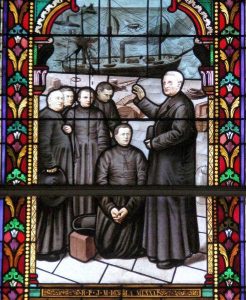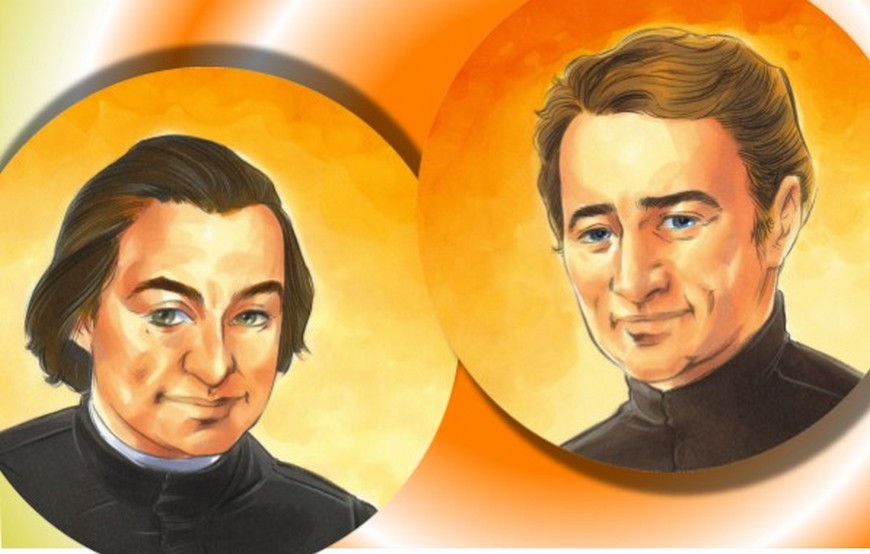
EVENTS… month after month… 200 years ago :
December 1820: Gabriel Deshayes becomes Assistant to Father Duchesne, Superior General of the Montfortians.
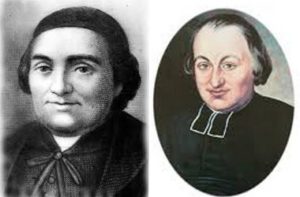 On 30th April 30, 1812, Father Deshayes and Father Duchesne, Superior General of the Montfort Fathers, signed a treaty which confided to the Daughters of Wisdom the education of the deaf-mutes at the Chartreuse d’Auray. This is the beginning of an ever closer collaboration between the two priests.
On 30th April 30, 1812, Father Deshayes and Father Duchesne, Superior General of the Montfort Fathers, signed a treaty which confided to the Daughters of Wisdom the education of the deaf-mutes at the Chartreuse d’Auray. This is the beginning of an ever closer collaboration between the two priests.
In 1820, the Compagnie de Marie had only seven members; it has just lost a valuable subject, Father Couperie promoted to the Episcopal See of Babylon. The health of Father Duchesne is more and more precarious. Conscious of the seriousness of his condition, he suggested to his missionaries to “aggregate Father Deshayes”. All give their agreement. We do not know exactly the circumstances in which Father Duchesne made his intention known to Father Deshayes, but we know that he went to Saint-Laurent-sur-Sèvre in November 1820. Before giving his consent, he thought it necessary to consult with his Bishop. With a great spirit of faith and disinterestedness, Bishop de Bruc replied: “If I consider the interests of my diocese, I must say to you: stay; but if I consider the general good of religion, I must say to you: go away. ”
On 20th December, Father Duchesne died. On 12th January, 1821, the missionaries elected Father Deshayes as Superior General of the Society. At the age 54, a new mission was opening for him.
November 1820 : the openings of schools of Father Deshayes in 1820
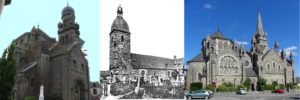 In 1820, in addition to the aid granted to Father de la Mennais for the opening of schools in the Côtes d’Armor, Gabriel Deshayes opened four new schools on his own account, including one in the Morbihan, at Pluvigner, not far from Auray. The other three: Tinténiac, Trans and Corps-Nuds are located in Ille-et-Vilaine.
In 1820, in addition to the aid granted to Father de la Mennais for the opening of schools in the Côtes d’Armor, Gabriel Deshayes opened four new schools on his own account, including one in the Morbihan, at Pluvigner, not far from Auray. The other three: Tinténiac, Trans and Corps-Nuds are located in Ille-et-Vilaine.
It is Brother Jean Le Mouroux who opened the school of Pluvigner and directed it during four years. His successor was Brother Theodosius Stephan.
In Tinténiac, the new priest, Father Courvaisier, found a school in a sorry state, entrusted to a “badly organised head in a man subject to getting drunk”. He wants to replace him. It is Father Couedro, his neighbour, Pastor of Montauban, who points out the Novitiate of Auray. Brother Julien Kerdavid, just 18 years old, arrives at Tinténiac in September 1820. The success is immediate. The young master imposes himself on his numerous pupils: 90, reports a report of 1820. Also, three years later, Father de la Mennais will not hesitate to entrust to him the important school of Saint-Servan.
In Trans and Corps-Nuds, the beginnings are more modest and the Brothers will leave these Communes in 1831 and 1832 respectively. (E.M. 9, p 56-61)
October 11th 1820: The Daughters of Providence settle in Rue du Ruisseau-Josse, today Charles Le Maout
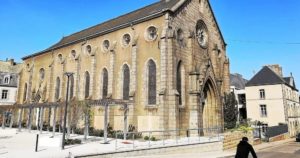 On the first of October, 1817, the Misses Cartel, Connan, and Chaplain, associated with Mlle Bagot, rented a house in the Rue de la Grenouillere to raise orphans. To occupy them, Mademoiselle Cartel ventured to teach them to read, write, and count. Soon, their numbers increased and externals joined the first recruits, so that the school changed its nature and became a real school. It was then that Miss Bagot left them to take care of the orphans only. As the number of students increased, new premises were needed. The work emigrated to rue Fardel, then rue Quinquaine, where there were soon more than 400 students. We had to move again.
On the first of October, 1817, the Misses Cartel, Connan, and Chaplain, associated with Mlle Bagot, rented a house in the Rue de la Grenouillere to raise orphans. To occupy them, Mademoiselle Cartel ventured to teach them to read, write, and count. Soon, their numbers increased and externals joined the first recruits, so that the school changed its nature and became a real school. It was then that Miss Bagot left them to take care of the orphans only. As the number of students increased, new premises were needed. The work emigrated to rue Fardel, then rue Quinquaine, where there were soon more than 400 students. We had to move again.
For some time Father de la Mennais had been planning to acquire the ancient property of the Ursulines, situated in Rue du Ruisseau-Josse; he could not afford it. Once more, he decided to appeal to the generosity of M. Jacques Sébert and his sister Antoinette. The purchase was made on 19th June, 1820 and the Daughters of Providence settled there on 11th October. The institution was now known as Providence. It sheltered, besides a flourishing school, the general administration and the Novitiate of the Congregation
Today, Providence and Saint Charles School have merged. Kindergarten and Primary schools remain on the place of foundation.
From the 9th to 15th September 1820 : the “Grand Retreat of Auray”
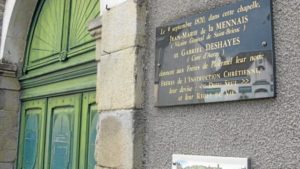 Brother Hippolyte Morin, in his memories, gives a very detailed account of this retreat that can be considered as a founder.
Brother Hippolyte Morin, in his memories, gives a very detailed account of this retreat that can be considered as a founder.
The year 1820 opened for the two Novitiates with the hope of being numerous at the next retreat which was to take place in Auray at the beginning of September as in other years. We waited with a kind of impatience for the time so much desired; it finally arrived, and it was given to us to see together the children of the two cradles of the little society, to make, according to the expression of our Founders, one and the same family. We were fifty. (NB: Brother Augustine speaks about 40, probably closer to reality). There are only 13 left when I write these lines.
The retreat opened on the 9th of September, at the Eternal Father, under the direction of the two Superiors who on that very day gave us the name of Brothers of Christian Instruction, and gave us for motto these two words so expressive, and which Mr. Boudon repeated so often, with outpouring of the heart: “God alone!”
It was at this retreat that the Rule was published: our Father de la Mennais read it, and we listened to it with the greatest attention. Several copies of the Rule were made, so that a copy could be given to each establishment. It was at the end of this retreat that the first vows were pronounced and the first ceremony of taking of the habit was held. I will always remember that I had the good fortune to be part of it. These first vows were for one year. (Brother Augustin specifies that it was only the Vow of Obedience).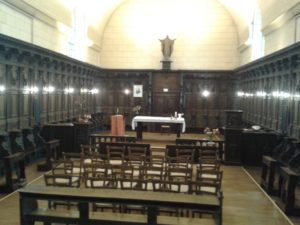
At last the farewells were made, and we parted. Our Brothers of St Brieuc, and our father De la Mennais at their head, returned by the road of Baud, through Pluvigner; our other Brothers went to their respective establishments. As for us, we returned to it by the Chartreuse which we visited. After the visit of this community, we returned to Auray, and the little Novitiate returned to its solitude.
Present also was Féli de la Mennais who attended all the exercises in a stall of the Chapel. (See Crosnier II, p 153). At that time, Féli resided in Saint-Brieuc with his brother Jean Marie who had invited him to Auray. He made the trip on horseback. (Correspondence of Féli, L 584)
August 1820 : Guingamp mission
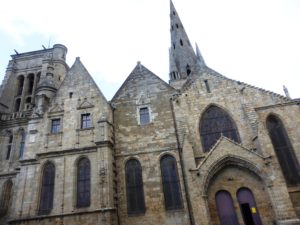 We owe to Brother Victor Gautier who ran the Guingamp School from 1825 until 1861, the date of his death, a relationship of the mission of 1820. “Guingamp had fallen into great religious apathy. Monsieur le Guyader, priest, thought that a mission was the only way to awaken the faith of the people. The mission began August 15th, 1820 and it regenerated the spirit of the population: the Christian school was the fruit and the memory of this mission. “. (EM11, p 27)
We owe to Brother Victor Gautier who ran the Guingamp School from 1825 until 1861, the date of his death, a relationship of the mission of 1820. “Guingamp had fallen into great religious apathy. Monsieur le Guyader, priest, thought that a mission was the only way to awaken the faith of the people. The mission began August 15th, 1820 and it regenerated the spirit of the population: the Christian school was the fruit and the memory of this mission. “. (EM11, p 27)
Bishop Laveille places in Guingamp this episode which illustrates the eloquence of the Father. “At the time of the sermon, the preacher cannot make his way to the pulpit. Throwing his eyes down the nave, he sees in the square, at the entrance to the church, a compact crowd of bourgeois and peasants, women of all classes, young men and children, who seem to implore him with the look. Immediately he goes out and goes to stand near the public fountain […] We hastily raise a rustic platform and it is from the top of this pulpit that he gives his first sermon … “(Laveille, Volume 1, p 260)
It is understandable, after such a success, that the subscription raised the sum of 4 to 5000 francs, which covered the first expenses of foundation of the school.
July 1820 : Publication of the second volume of the Essay on Indifference
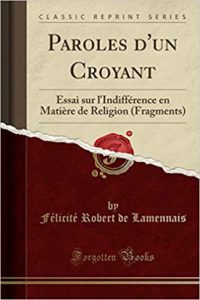 Féli became famous in Europe with the publication, in 1817, of the first volume of his “Essai sur l’indifférence en religion”. This first volume was a triumph. With a circulation of 13000 copies, it is also translated into English, Dutch, Italian, Spanish and German.
Féli became famous in Europe with the publication, in 1817, of the first volume of his “Essai sur l’indifférence en religion”. This first volume was a triumph. With a circulation of 13000 copies, it is also translated into English, Dutch, Italian, Spanish and German.
On the other hand, when the second volume appears, at the beginning of July 1820, things are different. While there is much praise and approval (Father Rohbacher and Bishop Lambruchini, for example), the author is more sensitive to violent criticism from all sides, even though he assures that he was waiting inevitably. He declares himself ready for a direct confrontation of his ideas, but at the same time his defence system is easy: “They do not hear a word of what I said” (Correspondence de Féli, L563). Later, on November 9th , he returns to the controversy with his close friend, Benoît d’Azy. “There was a lot of bad faith in some of my opponents. That we do not understand, or that we do not approve, is very simple, but we must not make a man say the opposite of what he says formally. For the rest, the spirits return. At first I received but few objections; now I receive justifications from all sides. Time will do the rest. »(L 603)
Alas! Fifteen years later, the verdict of Rome will be cruel and without appeal. The philosophical system of “common sense”, pushed to its limits, was condemned.
June 1820: Féli’s long stay in Saint-Brieuc
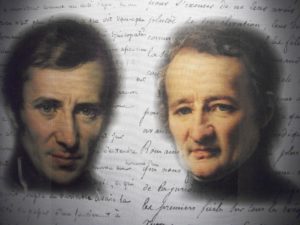 After two months spent at La Chesnaie from January 4th to March 9th, Féli moved to his home in Passy where he put the finishing touches to the second volume of the Essai sur l’Indifférence. He visits Paris only on Sundays and complains to his brother confidant, Benoît d’Azy: “I need retirement, rest and obscurity. In Paris, none of this is found. The Preface of his work is almost complete, he joins his brother in Saint-Brieuc on June 1st and will stay there six months until January 8th, 1821, including the Summer months spent in La Chesnaie. He hopes to associate him with his own work and he reveals this to the Baron de Vitrolles: “I foresee that my brother will soon be forced to withdraw, and until he can wisely take a decision, I cannot take one myself, having both the desire to live together.”
After two months spent at La Chesnaie from January 4th to March 9th, Féli moved to his home in Passy where he put the finishing touches to the second volume of the Essai sur l’Indifférence. He visits Paris only on Sundays and complains to his brother confidant, Benoît d’Azy: “I need retirement, rest and obscurity. In Paris, none of this is found. The Preface of his work is almost complete, he joins his brother in Saint-Brieuc on June 1st and will stay there six months until January 8th, 1821, including the Summer months spent in La Chesnaie. He hopes to associate him with his own work and he reveals this to the Baron de Vitrolles: “I foresee that my brother will soon be forced to withdraw, and until he can wisely take a decision, I cannot take one myself, having both the desire to live together.”
Is he looking forward to settling permanently in Brittany? What is certain is that he is looking for an opportunity. By an intermediary (Joseph Cor) he set a first course on Trémigon, Combourg, but the financial claims of the owner seem exorbitant (February). He then speaks of another project: a small house with a small chapel and a small farm, by the sea, at the Rosary, near Saint-Brieuc. Greve mortgages, this house proves unmarketable (May). Then, still in the bay of Saint-Brieuc, an old castle, large and well repaired with beautiful gardens and an eight acre wood on a hill, along the sea, makes him dream (end of June). It was the property of Saint-Ilan. Unfortunately, the owner is still too greedy on the price. We know that he will return to his first choice and buy Trémigon, which he will sell a few years later to his brother-in-law Ange Blaize de Maisonneuve. (General Correspondence of Feli, Letters 512, 537, 543, 546, 548 and Jean, L 940)
May 1820 : The battle of the mutual school continues. New schools in Côtes d’Armor
 A year and a half after the opening of the mutual school of Saint-Brieuc and the school of the La Salle Brothers, the school battle continues. Indeed, Mr. Remond, the Director of the mutual school is a very capable man and undertakes to train new masters in his method for the mutual schools of the department.
A year and a half after the opening of the mutual school of Saint-Brieuc and the school of the La Salle Brothers, the school battle continues. Indeed, Mr. Remond, the Director of the mutual school is a very capable man and undertakes to train new masters in his method for the mutual schools of the department.
Father de la Mennais does not remain inactive. In January, he called Brother Paul Guyot at the Novitiate of Notre-Dame Street. In early May, he transfers Brother André Labousse from Dinan to assist him, and this allows him to join to the Novitiate a Primary School with two classes and to accommodate the children that the La Salle Brothers cannot receive. In addition, in Plérin, the Mayor and the Parish priest do their utmost to get a Brother and open two weeks later at the gates of Saint-Brieuc, a school entrusted to Brother Simon Le Goff in the first year, and then the following year to Brother Michel Tréhen. The workforce will quickly reach 100 students.
On Saint-Brieuc, supporters of the mutual school are hurrying to build a new room. Able to receive 400 students, it can open on December 20 and will not exceed 170 students. Father de la Mennais has preceded them: he totals more than 500 students by counting the 280 children of the La Salle Brothers, the 120 of the Notre-Dame Street and the hundred of Plérin. Lamballe and Guingamp (in September) will also open a school of Brothers to compete with the mutual school. For Plouguernével, the problem is different. The old Seminary was bought in March 1820 by Father de la Mennais in the name of the diocese. The Bishop wants to establish an ecclesiastical college there. Pending the necessary enlargements, two Brothers (Adrien Simon and Alain Coursin) are appointed. The school will reach a total of 120 pupils in 1822. (cf EM 11, pages 19 to 32, CG II, L 930)
April 1820: Miss Amable Chenu and the Daughters of the Heart of Mary
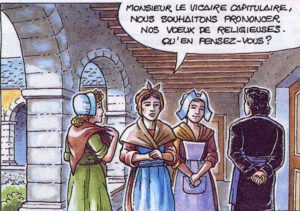 A letter dated 8thApril to Amable Chenu of whom he is the spiritual director reminds us of the links of Father de la Mennais with the Society of the Heart of Mary. He is one of the members of the men’s Society founded by Father de Clorivière. He continues to ensure the spiritual direction of the group of members of Saint-Malo of which Amable Chenu is the Superior.
A letter dated 8thApril to Amable Chenu of whom he is the spiritual director reminds us of the links of Father de la Mennais with the Society of the Heart of Mary. He is one of the members of the men’s Society founded by Father de Clorivière. He continues to ensure the spiritual direction of the group of members of Saint-Malo of which Amable Chenu is the Superior.
In Saint-Brieuc, Miss Cartel, Conan and Chaplain made their Novitiate and made their vows on 15th August, 1819, in accordance with the Constitutions of the Society of the Daughters of the Heart of Mary. But the attempts of Bishop de la Romagère to interfere in the internal affairs of the community of Providence inspire Father de la Mennais the project of erecting it as an independent religious Congregation. He warned Madame de Saisseval, Superior General of the Daughters of the Heart of Mary, on 29th January, 1821. With effect from the 25th March onwards, the Daughters of Providence pronounce their first vows in the new Congregation. The Constitutions remain those of the Society of the Daughters of the Heart of Mary, to which Father de la Mennais adds a special Directory. The Final Rules will be printed in 1833. (CG II, L 929, 950, 951)
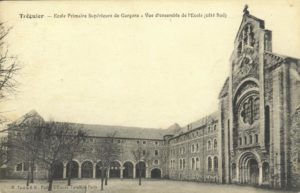 March 1820 : Constant concern for the Patrimony of the Diocese.
March 1820 : Constant concern for the Patrimony of the Diocese.
During the five years he spent in Saint-Brieuc as Capitulary Vicar, Father de la Mennais never cease to remind the government officials their duty to return all Church goods stolen during the Revolution. Some files are still pending, like the return of the Episcopal Palace (Bishop’s House) A letter to the Minister of the Interior dated Feb. 17 (CG II, Doc 196) reminded him about that subject. On another matter, to Fr. Berthier, Parish priest of Dinan, the Bishop is worried about the dispositions to be taken so that the Ecclesiastical School, for which he is the legal owner, would be recognised, at his death, as property of the Church. He puts some pressure for, at least, having a written will in that line (CG II, Doc. 197). Third file: acquiring the former Great Seminary of Tréguier in order to start, in it, the future Ecclesiastical College, indispensable in that part of the diocese. Already, Father. de la Mennais was successful in getting back to the diocese part of the buildings occupied by the municipal police. Documents still have to be signed. Furthermore, Bishop de la Romagère has started, with Mr. Caro, owner of the second part, the procedures that will be agreeable by both parties for the sale. An authorisation is needed as well as subsidies from the state to face the buying and the repairs of the place (CG II, Doc 200)
These three letters, signed by the new Bishop, bear the mark of the Vicar general, who was responsible for drafting it.
February 1820 : first offer of resignation of Father de la Mennais.
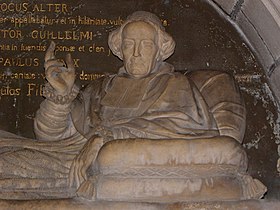
As soon as he returned from La Chesnaie, in a short letter of 29th January, Father de la Mennais handed in his resignation as Vicar general: “Monseigneur. Serious and painful motives force me to place in your hands the title and powers of Vicar general that you have kindly given me.” Signed: J.M. de la Mennais, Honorary Canon of Rennes
It will take two more letters for the Bishop to accept the resignation of his Vicar general, on 31st January, 1821, but “he retains all powers related to the confession and entrusts him especially the care and administration of the small schools for which he was already very helpful. Meanwhile, on the advice of Fathers Vielle and Nanthois, the Vicar general agrees to stay in Saint-Brieuc to prevent the serious inconveniences that could result from a sudden departure, and remains willing to provide the Bishop information that he will would deem fit to ask.
The statement he made at the end of the year to the Grand Chaplaincy is eloquent: “The most complete disorder reigns in the diocese, the division is almost everywhere; business is abandoned, everything is in pain and threatens ruin … “(CG II, Letters 933, 934, 936, 944)
January 1820 : Father de la Mennais retires to La Chesnaie for three weeks of rest.
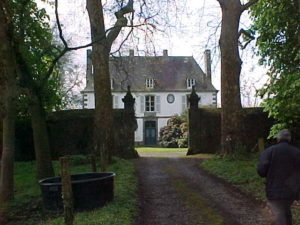 Bishop de la Romagère has just taken possession of the Episcopal See of Saint-Brieuc since the 11th November 1819 and has appointed Father de la Mennais, first Vicar general. The latter rightly thinks he has the right to breathe a little and goes to La Chesnaie for three weeks of rest. In addition, Féli has been there for a few days. Another reason explains his momentary withdrawal from Saint-Brieuc: it is already “the sad quarrels that have happened in the Chapter for a few weeks” as he explains in a letter of 15th January to an ecclesiastical friend. These quarrels concerned the derogations granted by Bishop Cafarelli to Abbe Vielle, Superior of the Major Seminary, that some, taking advantage of the arrival of a new bishop, wanted to oblige, as a titular Canon, to be present at all the offices. of the Cathedral. The multiple occupations of the Rector of the major Seminary amply justified this derogation and the Father strongly protests against these abusive claims. (CG II, Letter 925) Before leaving for La Chesnaie, Father de la Mennais had appointed Brother Paul Guyot, Director of Pordic, responsible for the Novitiate in Notre-Dame Street. (Cf CGII, L846, 847, 848, L864, L915)
Bishop de la Romagère has just taken possession of the Episcopal See of Saint-Brieuc since the 11th November 1819 and has appointed Father de la Mennais, first Vicar general. The latter rightly thinks he has the right to breathe a little and goes to La Chesnaie for three weeks of rest. In addition, Féli has been there for a few days. Another reason explains his momentary withdrawal from Saint-Brieuc: it is already “the sad quarrels that have happened in the Chapter for a few weeks” as he explains in a letter of 15th January to an ecclesiastical friend. These quarrels concerned the derogations granted by Bishop Cafarelli to Abbe Vielle, Superior of the Major Seminary, that some, taking advantage of the arrival of a new bishop, wanted to oblige, as a titular Canon, to be present at all the offices. of the Cathedral. The multiple occupations of the Rector of the major Seminary amply justified this derogation and the Father strongly protests against these abusive claims. (CG II, Letter 925) Before leaving for La Chesnaie, Father de la Mennais had appointed Brother Paul Guyot, Director of Pordic, responsible for the Novitiate in Notre-Dame Street. (Cf CGII, L846, 847, 848, L864, L915)
December 1819 : Reactions to the Brochure on Mutual Education published by Jean-Marie de la Mennais
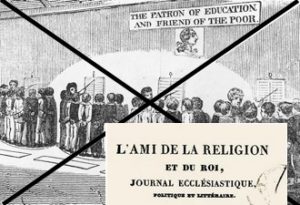 It was throughout the year 1819, since the opening of the Mutual School of Saint-Brieuc by Mr. Remond, competent and enterprising Director, that Fr. de la Mennais never stopped fighting, with the strongest energy, this pedagogical novelty which had the favour and the displayed support of all civil authorities. We saw him at work about the opening of the Dinan School where he managed to get ahead of his opponents. When the opportunity arises, the Vicar Capitular is not afraid to use the pulpit of the cathedral to castigate the method. And after the solemn distribution of the prices of the Mutual School in mid-August and the virulent speech of its Director, he wrote, in just one week, a pamphlet entitled “Of the Mutual Teaching, by JM de la Mennais, Vicar general of the Diocese of Saint-Brieuc “. Printed at Prodhomme, this booklet is widely distributed and has a great impact even in the Paris press. “The Friend of Religion” gives a large excerpt and presents it as “an excellent summary of the main difficulties encountered in Mutual Education. One recognises at once the zeal of a worthy Minister of religion, the glance of a judicious observer, and the talent of a distinguished writer “(Laveille, Vol. I, p. 241).
It was throughout the year 1819, since the opening of the Mutual School of Saint-Brieuc by Mr. Remond, competent and enterprising Director, that Fr. de la Mennais never stopped fighting, with the strongest energy, this pedagogical novelty which had the favour and the displayed support of all civil authorities. We saw him at work about the opening of the Dinan School where he managed to get ahead of his opponents. When the opportunity arises, the Vicar Capitular is not afraid to use the pulpit of the cathedral to castigate the method. And after the solemn distribution of the prices of the Mutual School in mid-August and the virulent speech of its Director, he wrote, in just one week, a pamphlet entitled “Of the Mutual Teaching, by JM de la Mennais, Vicar general of the Diocese of Saint-Brieuc “. Printed at Prodhomme, this booklet is widely distributed and has a great impact even in the Paris press. “The Friend of Religion” gives a large excerpt and presents it as “an excellent summary of the main difficulties encountered in Mutual Education. One recognises at once the zeal of a worthy Minister of religion, the glance of a judicious observer, and the talent of a distinguished writer “(Laveille, Vol. I, p. 241).
The pamphlet, written in haste, is not without flaws. Mr. Bienvenue, a Briochin lawyer, whom the partisans of the method charge to give the reply to the Vicar general, skilfully uses irony and moderation to try to diminish its media reach. Nevertheless, this writing contributed to the decline of the infatuation for Mutual Education, less however than the political reversal of December 1820 which marked its end.
In 1819, Gabriel Deshayes, very generous with Father de la Mennais for Dinan, could only open two schools, one at Plumeliau and the other at Montauban-de-Bretagne.
November 15th , 1819: Arrival of Msgr de la Romagere as Bishop of Saint-Brieuc
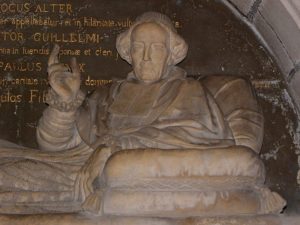 Upon taking possession of his seat, the new Bishop appointed Father Jean-Marie de la Mennais as first Vicar General and Father De Nantois as second to replace Father Manoir who died in April.
Upon taking possession of his seat, the new Bishop appointed Father Jean-Marie de la Mennais as first Vicar General and Father De Nantois as second to replace Father Manoir who died in April.
It is not without great apprehension that Father de la Mennais sees the arrival of his new Bishop. On September 15th , at the official announcement of the appointment, he wrote to Bishop de Quelen: “So this is the fate of the diocese of Saint-Brieuc fixed; we will have Msgr. de la Romagere for Bishop! We must resign ourselves, and try to draw good from even evil. “(L 908). A little later, October 3rd : “Not knowing where to take Father de la Romagere, who always writes to me from a place where he will not be the next day, I send you for him an open package, and I beg you to seal it before handing it to him. “(L 918).
Very quickly, the Vicar General judges his situation untenable and resigns “for serious and painful reasons”: it will be refused (L 926). The third petition (L946) will be the good one, January 31st , 1821.
It is undoubtedly on this date that we must place the famous episode of the repurchase of the old Major Seminary of Tréguier by Father de la Mennais. (For historical details, see the article by Brother Evergilde-Marie Quéau in the Chronicle 241, January-March 1965, P.55)
October 1819: Second Mission of Saint-Brieuc
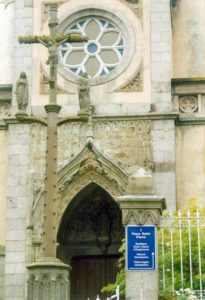 Before the arrival of Msgr de la Romagère, officially appointed at Saint-Brieuc since early September, Father de la Mennais took advantage of the passage of the Jesuits of Tours en route to Brest to organise a second Mission at Saint-Brieuc. But he reserves the opening sermon for himself.
Before the arrival of Msgr de la Romagère, officially appointed at Saint-Brieuc since early September, Father de la Mennais took advantage of the passage of the Jesuits of Tours en route to Brest to organise a second Mission at Saint-Brieuc. But he reserves the opening sermon for himself.
Let us borrow from Father Laveille (Vol. 1, p. 259) the following picturesque details: “The exercises are announced, and he ascends to the pulpit for the opening sermon. As he looks around the audience, he realises that the Cathedral is full, and that, outside, in front of the big open door, hundreds of people are trying in vain to enter.
So, very simply, addressing the huge crowd: “I’m going down,” he said, “I’m not preaching here. Follow me, I go up Rue de la Vicairie and I will give my sermon on the place Saint-Pierre ”. And crossing the ranks of the audience, he goes away, under the bright sun, dragging after him, a whole people. When he reached St. Peter’s Square, he climbed a hill. A simple chair serves him as a support and, from the heights of this humble platform, he throws a passionate and panting multitude of disagreeable utterances which upset souls and tear away tears. ”
After such an introduction, it was easy for the Jesuits to organise the continuation. In Brest, things will happen differently because serious troubles will occur there. (See L 920)
September 1819 : Two separate Retreats, Saint-Brieuc and Auray
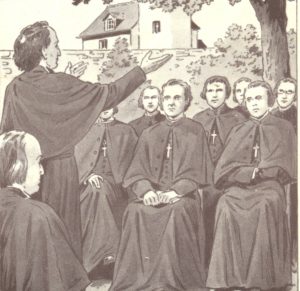 In 1819, the Founders do not consider it appropriate to gather their subjects for a common retreat. Both are held in September. That of Auray deserted the Maneguen, seat of the preceding exercises, to occupy a room of the College of Father Humphry. Father Deshayes gives the instructions to about twenty Novices and Brothers placed, assisted by Father Francis, S.J., professor at the Minor Seminary of Sainte-Anne d’Auray. In their memories, Brothers Hippolyte Morin, Julien Kerdavid and Augustin give us some echoes.
In 1819, the Founders do not consider it appropriate to gather their subjects for a common retreat. Both are held in September. That of Auray deserted the Maneguen, seat of the preceding exercises, to occupy a room of the College of Father Humphry. Father Deshayes gives the instructions to about twenty Novices and Brothers placed, assisted by Father Francis, S.J., professor at the Minor Seminary of Sainte-Anne d’Auray. In their memories, Brothers Hippolyte Morin, Julien Kerdavid and Augustin give us some echoes.
In Saint-Brieuc, the exercises bring together about ten retreatants: Brothers Paul, Charles, Gabriel, André, in office at Pordic or Dinan, and perhaps Bonaventure, all come from Auray, the three recruits of Father Tresvaux, and some aspirants who arrived during Summer: Brother Paulin surely ; it is difficult to be positive for Brothers Adrien, Michel, Simon … we do not know the exact date of their entry into the Novitiate.
Brother André Labousse gave his retreat impressions. They reflect well the fervour and emotion that characterised it: “It was (Father de la Mennais) himself who preached it in one of his apartments. (He) spoke to us with so much soul and anointing that we were all penetrated and convinced of the truths he announced to us. From then on, I was pushed towards him with an irresistible impetus and I had for him a deep veneration. “(EM 5, p 63-64)
August 1919 : Misses Conan, Cartel and Chapelain make their First Vows.
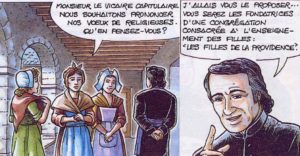 Letter 903 of 9th September to Mme de Saisseval, Superior General of the Daughters of Mary, tells us that the three young ladies Conan, Cartel and Chapelain pronounced their first Vows in her Society before Father de la Mennais on the15th August. Their Novitiate time was slightly shortened, their first consecration dating only from 8th September, 1818, but “their proven virtue and their great merit” amply justify this anticipation.
Letter 903 of 9th September to Mme de Saisseval, Superior General of the Daughters of Mary, tells us that the three young ladies Conan, Cartel and Chapelain pronounced their first Vows in her Society before Father de la Mennais on the15th August. Their Novitiate time was slightly shortened, their first consecration dating only from 8th September, 1818, but “their proven virtue and their great merit” amply justify this anticipation.
“Their work is in full swing: their school has seven classes: three of reading, two of writing, one of sewing and one of embroidery. I gave the name of Providence to the house they rented. An excellent layman has provided me with sufficient funds for things to go well. Seven young ladies are getting ready to join the same Society soon »
Consequently, Father de la Mennais asked Mme de Saisseval for twelve copies of the Rule of the Society, to be confided to her sister Marie (Mme Blaise de Maisonneuve), on a trip to Paris, who will pass through Saint-Brieuc on her return. We know that, subsequently, in the face of certain claims of Msgr. De la Romagère, Father de la Mennais deems it necessary to keep the full direction of this nascent work and will make it a new institution under the name of the Congregation of the Daughters of Providence.
After this celebration, Father Jean-Marie will take a week’s rest at La Chesnaie with Féli, visit with him Mont Saint-Michel and spend 3 or 4 days in Saint-Malo
July 1819 : Beginning of the Novitiate of Saint-Brieuc and a “long tour” in the diocese.
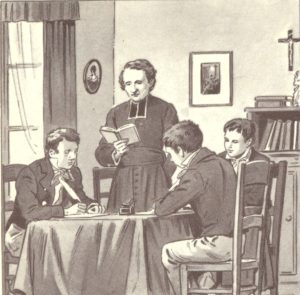 According to the studies of Brother Celestin-Paul Cueff based on the research of Brother Henri Rulon, the arrival of recruits La Roche-Derrien must have been between 12th June and 4th July. On 6th June, before leaving for Dinan, Father de la Mennais wrote to Father Élies, Parish priest of Lannion: “I will be back on Saturday (June 12th ) – I propose to go to see you in the early days of July “. And on the 4th July, from La Chesnaie, Féli wrote to Miss Lucinière: “We will leave at the end of August for Paris. Unfortunately my brother will not be travelling: a Novitiate of little Brothers he establishes in St-Brieuc, in his own house, will not allow him to be absent. “. Brother Celestin-Paul concludes that the first Postulants, Yves Le Fichant (18 years old), Allain Coursin (20 years old) and Jean-François Mindu (16 years old), had to arrive in Saint-Brieuc during this second half of the year. June. (See EM5, p 56)
According to the studies of Brother Celestin-Paul Cueff based on the research of Brother Henri Rulon, the arrival of recruits La Roche-Derrien must have been between 12th June and 4th July. On 6th June, before leaving for Dinan, Father de la Mennais wrote to Father Élies, Parish priest of Lannion: “I will be back on Saturday (June 12th ) – I propose to go to see you in the early days of July “. And on the 4th July, from La Chesnaie, Féli wrote to Miss Lucinière: “We will leave at the end of August for Paris. Unfortunately my brother will not be travelling: a Novitiate of little Brothers he establishes in St-Brieuc, in his own house, will not allow him to be absent. “. Brother Celestin-Paul concludes that the first Postulants, Yves Le Fichant (18 years old), Allain Coursin (20 years old) and Jean-François Mindu (16 years old), had to arrive in Saint-Brieuc during this second half of the year. June. (See EM5, p 56)
There are still some gray areas: did the three Postulants come to Saint-Brieuc without being accompanied? Were they led by Father Tresvaux or did Father de la Mennais take advantage of his visit to Lannion to cross the Roche-Derrien and take charge of them? In addition, to whom did he entrust them to this date, because a letter of 2nd August tells us that he has just finished a “long tour” in the diocese. (L 895). Perhaps he has already brought in a Brother of Christian Schools? or Brother Bonaventure Le Dain (28 years old), of the Novitiate of Auray, accompanied the three confreres of Dinan and remained in Saint-Brieuc as a cook and that the Father entrusted to him the responsibility of the group of young aspirants?
[expand title=”Show more”]
June 1819 : The Treaty of Union of 6th June , 1819
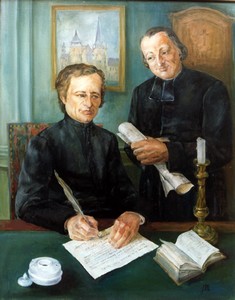 Certainly, for the Congregation of the Brothers of Christian Instruction, the major event of the year 1819 is the “Treaty of Union” signed on Sunday, the 6th June, between Father de la Mennais and Father Deshayes. This Treaty is rightly regarded as the Birth Certificate of the Congregation, even though the Retreat of September 1820 seals the first steps of the new Society more eloquently.
Certainly, for the Congregation of the Brothers of Christian Instruction, the major event of the year 1819 is the “Treaty of Union” signed on Sunday, the 6th June, between Father de la Mennais and Father Deshayes. This Treaty is rightly regarded as the Birth Certificate of the Congregation, even though the Retreat of September 1820 seals the first steps of the new Society more eloquently.
“Animated by the desire to provide the children of the people, especially those of the countryside of Brittany, with firmly pious Masters, we resolved to form temporarily at St. Brieuc and Auray two Novitiates of young people who will follow as much as possible the Rule of the La Salle Brothers of Christian Schools and will use their method of teaching … “(Doc 186)
This agreement is explained by the fierce battle led by Father de la Mennais against the establishment of Mutual Schools in the diocese of Saint-Brieuc. Defeated in Lamballe, Guingamp, Chatelaudren, Paimpol and Pontrieux, he wants, at all costs, to win at Dinan. He made contact with Father Bertier, the Parish priest, to convince him to second his project, and moves to Auray to seek the help of Father Gabriel Deshayes. In early June, the latter arrives at Saint-Brieuc with the three young teachers promised, namely, Brothers Charles Brottier, René Verdon and André Labousse. It is at the end of a week of common reflection that the text of the Treaty of Union is signed. Accompanied by the two Founders, the young teachers arrive in Dinan where nothing is ready to receive them. We deck with the essentials. Father Gabriel Deshayes leaves Dinan as early as Thursday, June 10th and shares his joy and confidence with Brother Jean Mouroux who accompanies him. Father de la Mennais remains in Dinan until Saturday to provide the last formalities. The solemn installation will be done in September. (EM 5, p 60-63)
May 1819 : The concern of all “Ecclesiastical Affairs”.
 “Ecclesiastical Affairs” is his “caseload,” as Father. de la Mennais wrote in another circumstance. What is it all about concretely?
“Ecclesiastical Affairs” is his “caseload,” as Father. de la Mennais wrote in another circumstance. What is it all about concretely?
It is necessary to regulate, with the Prefect and the “Ministry of the Interior and the Ecclesiastical Affairs”, the multiple questions relating to the salary of the Parish priests, the aid to the elderly priests, to the scholarships of Seminarians, to the recovery of the Chapels and Churches robbed during the revolution, the legal recognition of Religious Communities who are reconstituted and intend to recover their former Houses (L886), etc.
It is therefore necessary to regularly draw up the lists of persons (L 859: the Minister of the Interior admitted 213 Parish priests of the diocese), to intervene with the Communes to obtain a report of the Parish demonstrating the need for the Parish to have a priest (Doc 184, Doc 187, Doc 188, L863), make reminders when the sums allocated are not paid in time (ex: L912), reply to the Minister who requests information on the situation of the Major Seminary (L 881). On these questions, there are, for the only month of May and beginning of June, about ten letters addressed to the Prefect, the Grand Chaplain or the Minister of the Interior. (L 874 to 883)
April 1819 : Death of Father Manoir, the first Vicar Capitular.
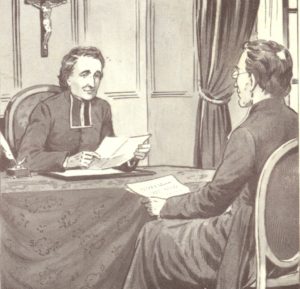 We know that in January 1815, the Chapter of Saint-Brieuc had appointed three Vicars Capitulars, the Fathers Manoir, Boulard and Floyd, to whom, because of the great age of these last two, he had added the Secretary of the Bishop, Father Jean-Marie de la Mennais. In fact, only Father Manoir could be of any help to him. And now, on 20th April, after six days of illness, Father Manoir dies. Father de la Mennais learns of it at Loudéac where he accompanies the Bishop of Vannes who begins a Confirmation tour planned for a long time. He hastily returns to Saint-Brieuc to preside over the funeral of the deceased. From now on, he will be really alone in carrying the weight of the diocese until the arrival of the new Bishop, not yet officially appointed.
We know that in January 1815, the Chapter of Saint-Brieuc had appointed three Vicars Capitulars, the Fathers Manoir, Boulard and Floyd, to whom, because of the great age of these last two, he had added the Secretary of the Bishop, Father Jean-Marie de la Mennais. In fact, only Father Manoir could be of any help to him. And now, on 20th April, after six days of illness, Father Manoir dies. Father de la Mennais learns of it at Loudéac where he accompanies the Bishop of Vannes who begins a Confirmation tour planned for a long time. He hastily returns to Saint-Brieuc to preside over the funeral of the deceased. From now on, he will be really alone in carrying the weight of the diocese until the arrival of the new Bishop, not yet officially appointed.
As in the past, the Vicar Capitular will have to deal with all ecclesiastical affairs. In the immediate future, he intends to benefit from the salary of 2000 Fr. attached to his post, not for himself: “I do not need this sum”, but “it will be useful to our institutions”. He writes in this sense to Bishop de Quélen, Vicar General of the Great Chaplaincy (L 873)
March 1819 : the concern, always present, of the education of the young people. Appeal to Father Tresvaux.
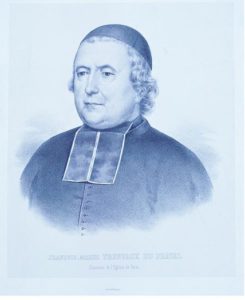 At the beginning of 1819, Father de la Mennais was particularly interested in the La Salle Brothers’ School opened on the 29th of the previous November and the bitter competition of the Mutual School: “Our Lancaster is a fuss,” he writes on February 4th. to M. Querret (L852). In fact, supported by the Prefect, Monsieur de Saint-Aignan, the Lancasterian Director opened a Normal School to train teachers in this method. Soon five cities, Chatelaudren, Paimpol, Lamballe, Pontrieux, Guingamp have a Mutual School. A Circular of the Prefect dated 20th March 1819, calls on the other Communes to adopt the procedure which he considers superior to all others. (See also 880 about Mr. Rémond)
At the beginning of 1819, Father de la Mennais was particularly interested in the La Salle Brothers’ School opened on the 29th of the previous November and the bitter competition of the Mutual School: “Our Lancaster is a fuss,” he writes on February 4th. to M. Querret (L852). In fact, supported by the Prefect, Monsieur de Saint-Aignan, the Lancasterian Director opened a Normal School to train teachers in this method. Soon five cities, Chatelaudren, Paimpol, Lamballe, Pontrieux, Guingamp have a Mutual School. A Circular of the Prefect dated 20th March 1819, calls on the other Communes to adopt the procedure which he considers superior to all others. (See also 880 about Mr. Rémond)
Aware of the danger, on that very day, 20th March 1819, Father de la Mennais wrote to his friend Tresvaux, the Parish priest of La Roche-Derrien, and asked him to find topics for the Society of Teachers he proposes to train as soon as possible. We do not have the Father’s letter, but Father Tresvaux’s answer of 22nd March was found in 1944 and confirms the request. The three young people will arrive at Saint-Brieuc only after mid-June. (EM 5, p 52-55)
The Vicar Capitular does not forget the girls. To his brother-in-law, Ange Blaize, he says, on the 11th March: “I have just finished a business to which I attached a great deal of interest; it is a school for little girls like that of the Brothers; it has definitely settled this morning; we will have at Easter a school of 200 – 300 girls. This is the House of Providence at Saint-Brieuc.
February 1819: The Vicar Capitular oversees the good administration of his diocese and defends his priests
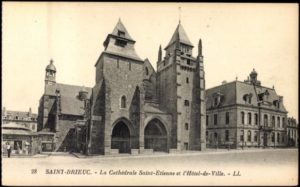 In Merléac, a rural parish of great extent, there is an ancient custom contrary to the regulations of the diocese that the Vicar Capitular wishes to abolish: the priests go to look for the bodies of the deceased in the places where they are deposited; sometimes they go there the day before. This results in extreme fatigue for the clergy. The Vicar Capitular demands the respect for the order of Bishop De Caffarelli who repealed this custom. (L855)
In Merléac, a rural parish of great extent, there is an ancient custom contrary to the regulations of the diocese that the Vicar Capitular wishes to abolish: the priests go to look for the bodies of the deceased in the places where they are deposited; sometimes they go there the day before. This results in extreme fatigue for the clergy. The Vicar Capitular demands the respect for the order of Bishop De Caffarelli who repealed this custom. (L855)
In Quillio, faced with a recurrence of a scandalous behaviour of the Vicar, Father de la Mennais forbids him any ecclesiastical function in the diocese and immediately names his replacement. (L 857)
In Pordic and Jugon, the priests refuse the religious burial to two people who committed suicide and, until their last moments, publicly expressed their opposition to the Catholic religion. Their relatives and friends cry scandal and seize the civil authorities. Father de la Mennais must write twice to the Minister of the Interior to justify the conduct of his pastors. (L871)
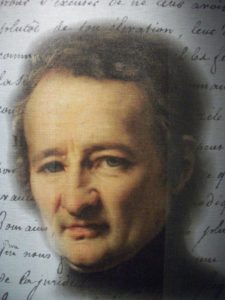
January 1819 : Daily worries of the Vicar Capitular. From the Colonel to the Prefect and to the Minister of the Interior, quarrel about a Military Mass.
The embarrassments of the Vicar Capitular are of all kinds and he must intervene many times to satisfy the Colonel of the Legion who intends to get a Mass for his troupe on Sunday at noon in the Cathedral. “For reasons of public order,” the midday Mass on Sunday had been suppressed for ten months before the arrival of the new Colonel. The first two tickets of January 16th (morning and evening) signify to the Colonel that we are willing to satisfy his request and that in the absence of a regular Military Chaplain, the Vicar Capitular found him a Priest available to celebrate the Mass. at noon in the College Chapel. The Colonel refuses this proposal. On the morning of Sunday, January 17th , Father Jean-Marie takes the pen to remind the Colonel that “no law or ordinance imposes on us to give the troops a special Mass and does not attribute to the Military Chiefs the right to fix the time and place where it would be said “and that he regrets the decision taken.
The dispute goes back to the Prefect, because Tuesday, January 19th , the Vicar Capitular takes the pen to justify the decision that was in his competence. On March 17th , returning to this affair, which went back to Paris, Father de la Mennais informed the Minister of the Interior that, in the circumstances, he had only the concern to enforce the law and laws of the Church and that the intervention of the Prefect was beneficial. A note sent to the Colonel on September 29th shows that things are then well appeased.
(See CGII, L846, 847, 848, L852, L864, L915). See also the letter of 2nd February to M. Querret (L852) where the Father alludes, not without irony, to the “red quarrel” he had with the Military.
DECEMBER 1818 : On December 25th , 1818, act of self-donation of the young ladies Cartel, Connan and Chaplain
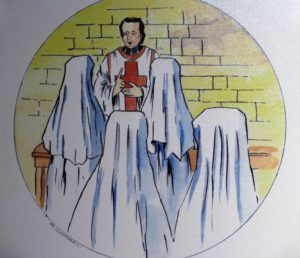 In the Annals of the Daughters of Providence, we find mention of this act of donation which precedes their religious consecration: “On Christmas night 1818 Miss Cartel, Connan and Chaplain met secretly in the chapel of Notre Dame du Refuge and recited in common an act of donation of themselves which preluded to their religious consecration. ”
In the Annals of the Daughters of Providence, we find mention of this act of donation which precedes their religious consecration: “On Christmas night 1818 Miss Cartel, Connan and Chaplain met secretly in the chapel of Notre Dame du Refuge and recited in common an act of donation of themselves which preluded to their religious consecration. ”
Eight days later, Ms Esther Beauchemin joined them by doing the same act of self-donation. Miss Bagot, the fourth associate of the beginnings, was separated from her companions to continue her apostolate with the orphans and found the Congregation of the Holy Family.
The four new associates then begin their Novitiate in order to join the Society of the Daughters of Mary, of which Madame de Saisseval is the Superior General. Their Novice mistresses are the Superior of the Hospice, a Sister of Saint Thomas de Villeneuve. (EM 5, p 7-8)
NB: In 1818, Gabriel Deshayes opened the Schools of Thénezay (Deux-Sèvres) and Baud in 1817 and Pordic, Limerzel, Malestroit and Ploërmel in 1818
NOVEMBER 1818: Arrival of the Brothers of the Christian Schools at Saint-Brieuc. Battle of the Mutual School.
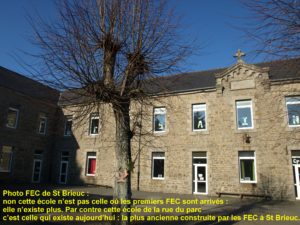
A year and a half passed between Father de la Mennais ‘first step on May 19, 1817, in Father Deshayes’ annotated letter to the Superior of the Brothers of Christian Schools, and the long awaited arrival of three Brothers.
It was time. Advocates of the mutual school had already succeeded in enrolling 175 children before three days later the Brothers began to receive the inscriptions. “The humble catalogue of the ignoramuses has quickly filled up, so that it contains at the moment more than 300 names … Of the 175 pupils enrolled for mutual teaching, only 50 appeared; the others are with the Brothers or will soon enter; the poor Lancastrian and his friends are enraged, they say; the people are in joy and I do not weep. “Wrote Father de la Mennais to his friend Querret.
In a letter to the Minister of the Interior, Father de la Mennais explains the two fundamental reasons for his opposition to the mutual school: 1st, because I believe this method dangerous; 2nd because, in this country, it has as partisans only the enemies of God and the King. (Letter 817.
The “battle” begun by Father de la Mennais begins with good augurs, this 29th day of November 1818, but is far from being over…
CGII: Letters 804, 817.835, 852 and, EM 5, p 52-54 and EM 43, p 73
OCTOBER 1818 : Jean-Marie de la Mennais settles down Rue Notre Dame, the future site of the Novitiate of Saint-Brieuc.
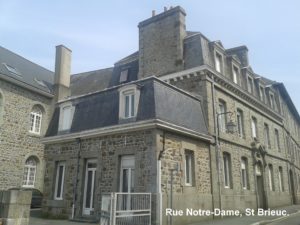 Jean-Marie de a Mennais left the house on Rue Saint Gilles where he had lived since 1814 to come and settle in Rue Notre Dame, in the convent of Monbareil. He made an advance of 12,000 francs to the Sisters of Charity of the refuge to help purchase the convent, in return for a rental of a sector of the house for his personal use. He took charge of the education of his nephew, the “little Angel”, son of Marie and Ange Blaize, whom he brought back from Saint-Malo to return from his September visit in Paris.
Jean-Marie de a Mennais left the house on Rue Saint Gilles where he had lived since 1814 to come and settle in Rue Notre Dame, in the convent of Monbareil. He made an advance of 12,000 francs to the Sisters of Charity of the refuge to help purchase the convent, in return for a rental of a sector of the house for his personal use. He took charge of the education of his nephew, the “little Angel”, son of Marie and Ange Blaize, whom he brought back from Saint-Malo to return from his September visit in Paris.
It was in this house that he received a few months later the first three subjects, among them Yves le Fichant, recruited by the Father Tresvaux, parish priest of La Roche Derrien. The Novitiate will operate at Notre Dame Street until its transfer to Josselin in August 1823.
SEPTEMBER 1818 : Second retreat of the Brothers of Auray. Retreats of the laity.
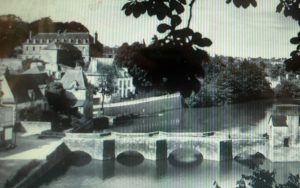
Let us leave the word to Brother Hippolyte Morin in his “Souvenirs”. “In the month of September, 1818, our Brothers, thirteen of them, again made their retreat with the Brothers of Christian Schools, at Maneguen. This time it was Fr. Guyomard, then curate of Malestroit, and then Missionary of St. Laurent, who gave instructions in one of the classes. The master’s desk was that of the preacher; the retreat resembled the preceding one: we rose at five o’clock and went to Father Deshayes’ room for the prayer and meditation that took place there.
Brother Hippolyte then recounted the well-known accident in which Father Deshayes, on the day of the opening of a lay retreat, wanted to assist Brother Pierre who had fallen into the cesspool, “Brother Hippolyte continued:” We know that he is the founder of the retreats that take place in the community of Père-Éternel d’Auray, at certain times of the year for both men and women. The first of these retreats took place in [November], 1818, precisely the day on which the accident of which I have just spoken occurred. He himself had to open it, but his condition did not allow him to do so; but the next day, with his head surrounded by compresses, he appeared among the ecclesiastics who worked there, and with his ordinary gaiety he joked the best in the world, the state in which he had been in the grave with his companion of misfortune, Brother Peter. ”
(“My memories about the Institute …”, by Brother Hippolyte Morin)
Summer 1818: rest, trips, deaths, stays in Paris, at la Chesnaie, of John and Féli.
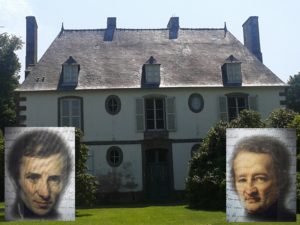 In early July, Féli left Paris, where he had just completed the publication of the 2nd edition of Vol. 1 of L’Essai sur l’indifférence and rejoined his brother John at Saint-Brieuc. From the 17th to the 27th, the brothers rested at La Chesnaie: “I have come back from La Chesnaie where I spent ten days with Féli; the diocesan problems did not allow me to delay any longer at Saint-Brieuc. This brief interval of rest has been useful to us both. (CGII, Lettre 772)
In early July, Féli left Paris, where he had just completed the publication of the 2nd edition of Vol. 1 of L’Essai sur l’indifférence and rejoined his brother John at Saint-Brieuc. From the 17th to the 27th, the brothers rested at La Chesnaie: “I have come back from La Chesnaie where I spent ten days with Féli; the diocesan problems did not allow me to delay any longer at Saint-Brieuc. This brief interval of rest has been useful to us both. (CGII, Lettre 772)
In early August, Feli arrived from Paris where he learned of the death of his brother Gratian at Havana. He was devastated. At the end of the Month another and equally painful trial awaited him: the premature death of his friend, Fr. Teysseyre, professor at Saint-Sulpice. He wrote laconically to John on the 23rd, “Last night at 2:30, our dear Teysseyre left life. He had been admirable during all his illness. Do not worry about my health. Another blow had prepared this one.”
As for John, he deemed it important to rejoin his brother in Paris. He stayed there Sept. 3rd until the 27th. He mentioned to his brother-in-law, Blaize, that the trip took 4` hours. The return would take longer: from Sunday evening, Sept. 27th until Wednesday morning, the 30th. He summarized the story of his stay thus: Feli is infinitely bettwr, I congratulate myself every day for having gone to see him, for otherwise I do not know what would have happened to him.”
CGII, p. 74, Lettre 800 à Ange Blaize
July 1818 : Understanding between Gabriel Deshayes and the Sisters of the Holy Spirit of Saint-Brieuc to benefit the future Sisters of Saint-Gildas.
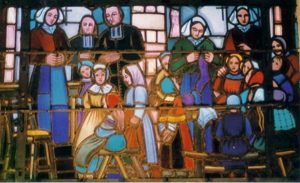 Since 1807, Gabriel Deshayes had brought a group of seven young ladies together at Beignon in order to make them teachers. A school for girls did open under the leadership of Michelle Guillaume, but their pedagogic and religious formation had to be provided.
Since 1807, Gabriel Deshayes had brought a group of seven young ladies together at Beignon in order to make them teachers. A school for girls did open under the leadership of Michelle Guillaume, but their pedagogic and religious formation had to be provided.
In view of this, Gabriel contacted the Daughters of the Holy Spirit in 1818, planning to join his group to that Congregation. By way of trial, he chose Michelle Guillaume and one of her companions to join the Daughters at their Motherhouse in Plérin. However, in view of certain hesitations on the part of the sisters and the lack of unanimity of their general council, he went to Plérin and decided to terminate the trial. He returned to Beignon with his two disciples.
After the June, 1819 meeting with Jean-Marie de la Mennais, he opted for the creation of a religious congregation in
1820. The seven lady companions pronounced their first vows on November 19, 1820, and six new recruits joined the
novitiate. That date is retained as the foundation of the Congregation of the Sisters of Christian Instruction..
Gabriel Deshayes, prêtre de la Providence, Jean Chéory, p. 118 et Laveau
June 1818 : Death of Gratien, the youngest of the La Mennais family.
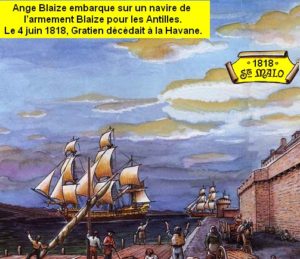 The behaviour of Gratien, the youngest of the family, had for years been a permanent problem for the family. He lived on the hooks of his brothers and sister and spent his money on drinks and frivolities, leaving them unpaid bills to pay for him. Thanks to their intervention, he had obtained a post of lieutenant in a regiment of the National Guard in Tours, but was excluded in early 1818.
The behaviour of Gratien, the youngest of the family, had for years been a permanent problem for the family. He lived on the hooks of his brothers and sister and spent his money on drinks and frivolities, leaving them unpaid bills to pay for him. Thanks to their intervention, he had obtained a post of lieutenant in a regiment of the National Guard in Tours, but was excluded in early 1818.
In December 1817, Jean-Marie had deemed it necessary to travel to Saint-Malo to study, with his brother-in-law, Ange Blaize, about the course of action concerning Gratien. They succeeded in getting him embarked on a ship of the Blaize armament for the West Indies, in second quality. On June 4, 1818, Gratien died, in Havana, of a vomit crisis caused by yellow fever. He was 33 years old. The news reached Brittany only in August.
Feli will be very much affected by this death: “Feli, on hearing of the death of poor Gratian, experienced a very violent nervous crisis, which lasted several hours …” (Letter 780 from John to Angel Blaize + Letter 667)
(CGI, Letters 185, 375, 508, 565-EM 43, p 42)
May 1818 : Urgency of the arrival of the Brothers: reminders to Brother Gerbaud, Superior General of the B.C.S.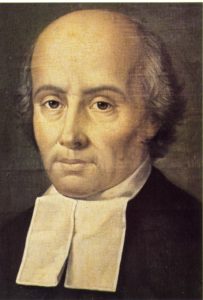
On May 5, 1818, Father de la Mennais resumed contact with Brother Gerbaud, Superior General of the Brothers of the Christian Schools, asking him, as promised, three brothers for October 1818 to counter the opening of the mutual school at Saint Brieuc. “Allow me to represent to you that it is very important that your brothers come in the month of October; I have believed, from what you have done me the honour of marking me, that I can assure the city, the Prefect, and through him to the Minister of the Interior, that our Christian schools would be established in this month. “.
On June 15, the Vicar-General was even more pressing, and on August 22, September 13 and 25, he reported on the steps taken by Charles, B.C.S. of Auray, which the Superior General sent to Saint-Brieuc to better account for the situation and to specify the needs for furniture and teaching diplomas. Brother Gerbaud then promised the Brothers for All Saints’ Day. On the 29th of November, 1818, practically the same year as the opening of the Mutual School.
CGII, Letters 743, 789, 796, 802
April 1818 : February to April 1818: “They do not give me time to breathe.”
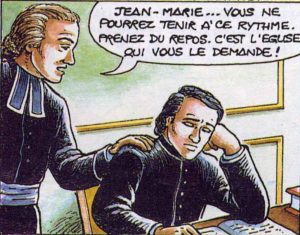 The commitment of the Vicar of Saint Brieuc to the service of his diocese remains total.
The commitment of the Vicar of Saint Brieuc to the service of his diocese remains total.
On the 16th of February, 1818, he wrote to his friend M. Querret: “Since Lent is begun, I confess, so to speak, from morning till night. This procession of men and young people pleases me singularly. ”
And to Bishop de Quenen, March 29, 1818: “They do not leave me time to breathe, since the Passover is open. The good Lord be blessed! ”
A little later, on April 24, to his brother-in-law Ange Blaize: “For me, I am more than ever crushed by work; I do not know how I care, the good God gives me strength. ”
A fortnight before, it was his brother Féli who advised him: “Take care of your health. I am afraid you will be exhausted a second time. Nothing tires you so much as to speak outdoors. If God allows you to do good, you must conserve your strength in order to do more. ”
GC II Letters 714, 729, 738
March 1818 : Controversy with the Minister of the Interior on the four articles of 1682.
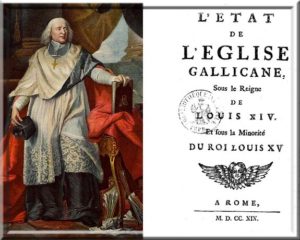 The Declaration of the Four Articles, drafted by Bossuet, was adopted in 1682 by the Extraordinary Assembly of the Clergy of France. This declaration defines the “liberties of the Gallican Church”, according to which:
The Declaration of the Four Articles, drafted by Bossuet, was adopted in 1682 by the Extraordinary Assembly of the Clergy of France. This declaration defines the “liberties of the Gallican Church”, according to which:
- the sovereign pontiff has only one spiritual authority; princes, therefore, are not subject to the authority of the Church in temporal things;
- the use of pontifical power is regulated by the canons of the Church; but, beside them, the principles and customs of the Gallican Church, which have always existed, must remain in force;
- the authority of the pope is limited by that of the general councils;
In matters of dogma, the Pope is infallible only with the consent of the universal Church.
(Excerpts from Wikipedia)
February 1818 : January 1 to 25, 1818: Mission of the parish of Pordic. Opening of a school
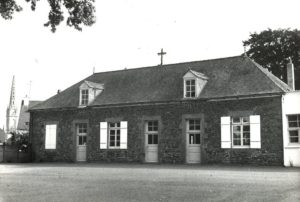 As Vicar Capitular, Father de la Mennais was one of the first to open missions in his diocese. The first great mission was that of Saint-Brieuc in 1816, then Loudéac in 1817; that of Pordic began on January 1, 1818, and lasted three weeks. Father de la Mennais made the opening.
As Vicar Capitular, Father de la Mennais was one of the first to open missions in his diocese. The first great mission was that of Saint-Brieuc in 1816, then Loudéac in 1817; that of Pordic began on January 1, 1818, and lasted three weeks. Father de la Mennais made the opening.
To consolidate the happy effects of the mission, Father de la Mennais obtained from Gabriel Deshayes brother Paul (Mathurin Guyot) to open a boys’ school. Mathurin Guyot was a native of Ploërmel and entered the novitiate of Auray on June 24, 1816. It was probably on the occasion of the Saint-Malo mission a few weeks earlier that Father de la Mennais negotiated this arrival, does not know the exact date.
Brother Paul left Pordic in May 1820 to teach at the novitiate of Saint-Brieuc and in September to take the direction of Dinan where he remained until his death in 1853. He had the full confidence of our founder.
The Brothers of Ploërmel held the Pordic school without interruption until 1978.
See Ménologe, Volume 1, p 485, GC II, Letter 692 of 5 January 1818, EM 9, p 35.
January 1818: Towards the end of the liquidation of the paternal business premises.
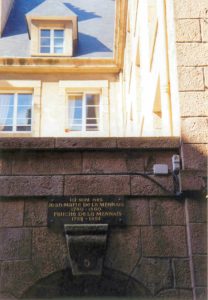 On December 29, 1817, Jean-Marie wrote to his brother-in-law, Ange Blaize: “The liquidation is rapidly coming to an end.” This is the liquidation of the commercial counter of their father and uncle declared in the middle of the year 1813.
On December 29, 1817, Jean-Marie wrote to his brother-in-law, Ange Blaize: “The liquidation is rapidly coming to an end.” This is the liquidation of the commercial counter of their father and uncle declared in the middle of the year 1813.
Bishop Laveille writes: “M. de la Mennais was old and incapable of carrying out the disastrous liquidation. Father Jean took in hand the wrecks of this great shipwreck… The creditors were fully satisfied with his uprightness and his energy… All was not over. M. de la Mennais and M. des Saudrais had nowhere to lay their heads. The Abbe Jean agreed with his sister and his two brothers, Felicite and Gratien, to make a lifetime pension to the two old men, who withdrew to Rennes.”
By settling in Saint-Brieuc on 18 March 1814, Father Jean had settled most of the affairs of the liquidation, but a few files remained unresolved at the beginning of 1818 as evidenced by the correspondence maintained between Jean and Féli and their brother-in-law Ange Blaize de Maisonneuve between 1814 and 1818
- Pierre Robert de La Mennais died on 24 January 1828 and the uncle of the Saudrais in mid-June 1829.
Laveille, Tome 1, p 137. Letters
December 1817 : The third meeting between Gabriel Deshayes and Jean -Marie de la Mennais
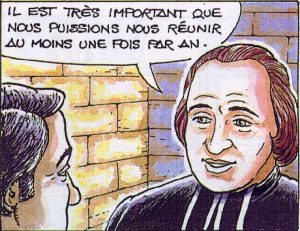 At the end of 1817 an occasion for the third meeting for the two priests presented itself. From the16th November to the19th December a mission was given to St Malo and St. Servan. The Assistance of Mr. Deshayes had been claimed by Augustin George, the pastor of Saint Servan. How could it be refused a friend who, during the Terror and in the middle of the worst dangers, shared his clandestine apostolate?
At the end of 1817 an occasion for the third meeting for the two priests presented itself. From the16th November to the19th December a mission was given to St Malo and St. Servan. The Assistance of Mr. Deshayes had been claimed by Augustin George, the pastor of Saint Servan. How could it be refused a friend who, during the Terror and in the middle of the worst dangers, shared his clandestine apostolate?
Without doubt Father Jean de la Mennais knew the participation of Father Deshayes in the undertakings of the missionaries and the worries caused by his brother Gratien – the youngest and the torment of the family – demanding his presence at the scene. Féli made his brother in-law Ange Blaize know about it: “I write to Jean to engage him to hasten his journey to St Malo. You will surely need to talk together about the course to take (regarding Gratien).” Meanwhile, Father Jean confirmed his intention; “I intend to go to St Malo in the second week of December: together we will then see what we shall have to do there.”
The journey took place, and the two priests met each other at Saint- Malo or Saint- Servan : we get this information by the Vicar of Pleudihen. This parish depended on the Diocese of Saint- Brieuc; but Father Glorio , its parish priest and the vicar had promised their support to the mission. On the 25th December 1817, the latter wrote to Father de la Mennais to whom he depended, to clear himself of an accusation: “I am angry against the report that you gave about me Father Glorio, the Rector of Auray and Father Georges: they were deceived.”
The Vicar capitular had a project in view and which he kept in his heart. We think that he took advantage of this new meeting to accomplish it. In January 1818 the parish of Pordic was itself entering in the mission. To prolong the happy fruits, Father de la Mennais wished to rapidly open a school for boys. It was from Father Deshayes that he waited for the teacher he needed. Always disinterested, the parish priest of Auray promised to give him one. The desired class opened in the early months of 1818.
EM 5, p 39-40 . CGI , L 606, L667 ; Crosnier I, p 284-288 .
November 1817 : On the 30th of November, publication of the first volume of the Essay on indifference in matters of religion.
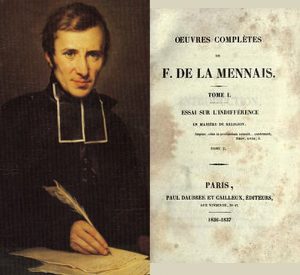 For some months now, Féli Mennais was writing a book of apologetics, on the pieces of advice and according to the personal notes that Father Teysseyrre, professor at St. Sulpice, had at his disposal and which dealt with indifference in matters of religion.
For some months now, Féli Mennais was writing a book of apologetics, on the pieces of advice and according to the personal notes that Father Teysseyrre, professor at St. Sulpice, had at his disposal and which dealt with indifference in matters of religion.
On the 30th November 1817, in a letter to Jean Marie de la Mennais, Féli de la Lamennais announced that the printing of the essay was completed. It is a book of 560 pages, sold at 6 fr.50.
The book was a great success and it was favourably welcomed everywhere, with some exceptions. In less than a year, 13,000 copies were sold. In 1818, it was translated into English, Dutch, and later in Italian, Spanish and German. The reputation of the Breton writer spread throughout Europe. But when the second volume appeared in 1820, critics kept more attention to the author. He also wanted to seek the judgment of Rome, which would prove favorable: “In the search for truth, we do not find in an individual man the principle of certainty: it is on the contrary, what men invincibly believe which constitutes the principle of certainty. In his “Essay” Lamennais highlights the strength of this common faith and, in my opinion, he does it with clarity. […] So, I think that this book is excellent and deserves publication. “(Rome, 29-04-1822 Basil Tomaggian, Penitentiary of St. Peter).
Formal approval of three Roman consultants did not disarm criticism, especially after the publication of the second volume. We note in particular the severe analysis of the Jesuit Rozaven who addressed to Féli in 1824 a substantive objection to his underlying thesis of “common sense.”
General correspondence of Féli, Letters to Jean de la Mennais from No. 226 to No. 242 .
Marechal , ” the infancy of la mennais “p 595 ff .
October 1817. The first steps of the Daughters of Providence at the Grenouillère Street.
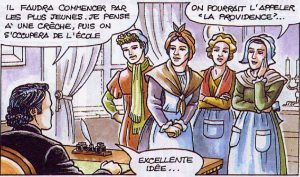 After the mission of 1816 at Saint-Brieuc, the president of the Congregation of the young celibate ladies was elected. Anxious to devote themselves to good works, she accompanied in the first time Miss Corbio a devout parishioner of the cathedral in her charitable errands. Miss Corbion soon died. Miss Cartel then joined Marie Connan, Chaplain Annie and Miss Julie Bagot. Together, under the leadership of the latter, they founded, in a house called the “Grenouillère”, an institution for the orphaned. She sent four of them to start.
After the mission of 1816 at Saint-Brieuc, the president of the Congregation of the young celibate ladies was elected. Anxious to devote themselves to good works, she accompanied in the first time Miss Corbio a devout parishioner of the cathedral in her charitable errands. Miss Corbion soon died. Miss Cartel then joined Marie Connan, Chaplain Annie and Miss Julie Bagot. Together, under the leadership of the latter, they founded, in a house called the “Grenouillère”, an institution for the orphaned. She sent four of them to start.
Then, the four associates agreed that they would also receive children in order to teach them catechism and the basics of reading and writing … But Miss Bagot found that this new activity came from the original objective, exhausted, at its profit, the meager resources of the institution, and suggested the returning of the school children. Father de la Mennais, sollicited as a referee, encouraged the two apostolate and Miss Bagot separated herself from her companions to continue, first alone, her ministry to the orphans.
From there would be born two religious congregations: the Sisters of Providence of Saint- Brieuc and the Sisters of Our Lady of Providence, who later became the Religious of the Holy Family.
Laveille I, p 292-299
September 1817: The retreat at Auray of the first disciples of Gabriel Deshayes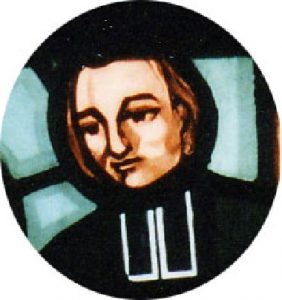
Here is what Brother Hippolyte Morin wrote about the first retreat of Auray in a letter dated 1st May 1868 to Brother Augustine Auvray of Saint-Laurent-sur-Sevre :
“In September 1817 they made a retreat with the Brothers of Christian Schools. As it was thanks to father Deshayes that these Brothers had their school (the school at Auray was the first they had in Brittany since the revolution of 1793) at Auray ( since it was him who called them there and who made them build classrooms at Manéguen (with two Briton words mané guen,white mountain), it was not difficult for him to get his young men, then seven in number, to carry out spiritual exercises with them. This retreat, the first that our Brothers had was given by a great friend of the father, father Villeneuve [ the chaplain of Chartreuse d’Auray, NdlR], in one of the classrooms of the Brothers because their oratory was too small. Between the exercises, the young postulants dispersed to go to confession, some to the Capuchins, others to the hospice, etc. They met at the parish for meals and sleeping.”
AFIC 080-06-005 Laveille I, note on page 331
AUGUST 1817. The retreat of the priests of the diocese of Saint-Brieuc. Father de la Mennais alerted the priests about the dangers of the mutual school.
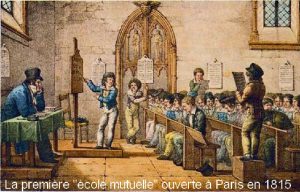 The diocese, under the leadership of Jean -Marie de la Mennais, organised two retreats for the clergy, the first in August and the second in September. The Vicar Capitular took the opportunity to draw the attention of the priests to the Carnot project, developed during the Hundred Days and advocating Lancasterian method. He warns against the dangers of the method and the ulterior motives of the designers (Doc 164, p 556 ) .
The diocese, under the leadership of Jean -Marie de la Mennais, organised two retreats for the clergy, the first in August and the second in September. The Vicar Capitular took the opportunity to draw the attention of the priests to the Carnot project, developed during the Hundred Days and advocating Lancasterian method. He warns against the dangers of the method and the ulterior motives of the designers (Doc 164, p 556 ) .
Already on the 16th June, in a letter to the parish priest of Saint-Servan, Jean -Marie de la Mennais wrote: “The method itself is vicious: children are in perpetual movement. […] We boasted much about how quickly children learnt what they showed to each other […] but is [their] moral education ended?”. And in August, during a visit to the Trégor, he brings together the members of the Committee of Primary Education of Lannion and warns against the Lancasterian method and the opening of a mutual school at Lannion (L 629 ) .
Two years later, the Father would develop in his pamphlet on the Mutuel teaching all the limitations and the real dangers of the method advocated by the government. He had already foreseen all this in 1817.
Both retreats were also an opportunity for the Vicars Capitular to seek official retraction of the constitutional priests. All but one, the senior priest of Paimpol, would accept the regularisation of their situation, thus sealing the unity of the priests of the diocese.
July 1817 : The signing of the new Concordat.
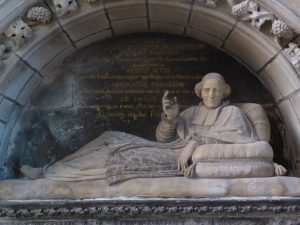
Mgr Cafarelli’s grave, in St-Brieuc
On the 11th June 1817, after three years of talks between the Ambassador of France to Rome and Cardinal Consalvi , on behalf of Louis XVIII and Pius VII, a new concordat was signed. It abrogated the one of 1801 and went back to the main provisions of the Concordat of 1516 with, however, some restrictions.
This Concordat foresighted 72 dioceses including the restoration of Saint-Malo. Having not been validated, it was never effected and France therefore remained under the Concordat of 1801 until the law of separation of 1905.
On the11th October, the final list of bishops appointed to vacant posts was issued. Bishop Groing de la Romagère was appointed to Saint- Brieuc, but he would only assume his responsibilities on November 15, 1819.
Faced with the imminent appointment of the new bishop, the vicars capitular suspended a number of decisions.
Cf CGI , L607 , 610, 611 .
At the beginning of June 1817: second meeting between Gabriel Deshayes and Jean -Marie de la Mennais.
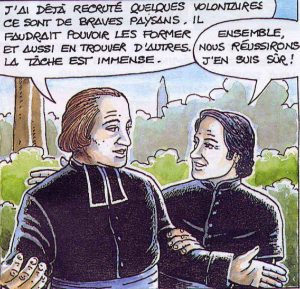 At the end of May or at the beginning of June 1817 (the General Correspondence of Jean-Marie de la Mennais between the 4th and the11th June had a vacuum), Father de la Mennais moved to Morbihan and saw, among others, Father Deshayes searching for three aspirants for the novitiate of the Brothers of Christian Schools, an indispensable condition for the Brothers to come to Saint-Brieuc.
At the end of May or at the beginning of June 1817 (the General Correspondence of Jean-Marie de la Mennais between the 4th and the11th June had a vacuum), Father de la Mennais moved to Morbihan and saw, among others, Father Deshayes searching for three aspirants for the novitiate of the Brothers of Christian Schools, an indispensable condition for the Brothers to come to Saint-Brieuc.
A letter of Father Tresvaux, recently appointed by the Vicar capitular to be the Parish Priest of Roche-Derrien, confirms this passage. On the 15th June 1817, he wrote to Father de Lamennais: “Eight days ago, I travelled to Sainte-Anne (Auray) and to Vannes … I have been delighted by the charity of the clergymen I met. They have not forgotten you and the Superior of Sainte-Anne asked me to tell you that he would be very glad if you reiterated your visits. ”
This visit to Gabriel Deshayes shows the interest that Father de la Mennais had in the coming of the Brothers of Christian Schools at Saint-Brieuc.
The three candidates requested for by the Brothers of Christian Schools entered the novitiate, the first one in July and the other two in September (CG II, L743 ) .
Cf Laveille I, p 181, EM 5, p 38.
May 10, 1817 : Jean -Marie de la Mennais and Gabriel Deshayes met for the first time.
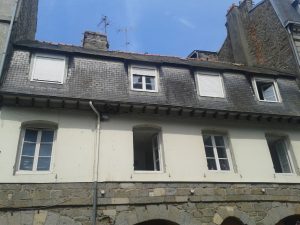
St Gilles Street, St-Brieuc
On the 10th May 1817, Gabriel Deshayes signed a letter of Jean -Marie de la Mennais to Brother Gerbaud , the Superior General of the Brothers of Christian Schools, in these terms: “Father de la Mennais asked me to join him to make you establish a school of your Brothers in the town of Saint- Brieuc. It is with great pleasure that I accept his invitation … ”
This date situates the first meeting of our two founders. According to Brother Celestin Paul Cueff (EM No. 5), the Parish Priest of Auray, Gabriel Deshayes, Vicar General of Vannes and Father de La mennais, Vicar Capitular of Saint- Brieuc, knew each other’s reputation, would it not be by the press, especially “the friend of religion” that had published on the 1st June 1816 an article consecrated to the works of charity of the Parish Priest of Auray.
But what did Gabriel Deshayes come to do at Saint-Brieuc on the 10th May 1817? Brother Augustine Auvray said: “The two founders wrote to each other and Father Deshayes went to Saint- Brieuc to communicate his thoughts to Father de La Mennais […]
It was in 1817. “And the journalist Louis Kergolay, after his interview with Jean -Marie de la Mennais in 1849, stated: ” Having had the notion of the undertakings of the diocese administrator of Saint- Brieuc where he was unknown, (Father Deshayes) spontaneously came to meet him.”
Without further explanations, we must welcome these testimonies, and certainly recognise in them the finger of Providence that favoured this meeting so fundamental for the beginnings of our Congregation.
BICENTENARY OF THE CONGREGATION
Two important dates, two founding events:
- On 6th June 1819: signing of the Treaty of Union by John Mary de La Mennais and Gabriel Deshayes.
- From the 9th to 20th September 20th, 1820: Grand Retreat of Auray in the presence of our two founders.
On 6th June 2019, we shall celebrate the 200th anniversary of the signing of the “Treaty of Union” by our founders.
In September, 2020, it will be the celebration of the 200th anniversary of the 1st retreat of our first Brothers in the presence of both founders. On this occasion they received the first Rule, the cassock, the crucifix, the name: Brothers of Christian Instruction, and the motto: God Alone.
We decided to celebrate this event by giving thanks for the past of our Congregation which, in spite of the trials, did not stop giving Brothers’ testimony together following Jesus, in the education of the little children and poor people.
We shall also celebrate this anniversary with a new missionary spirit. That is why we chose the slogan: “a new page”. We wish that this celebration may be the opportunity to listen to the calls of the Spirit and go to new mission lands.
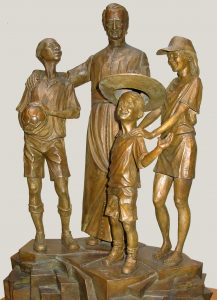 CALENDAR OF the BICENTENARY:
CALENDAR OF the BICENTENARY:
6th June 2017:
Launching of the 1st year, with the theme: Discerning together. We shall try to follow our two founders who had tried, each on his side, to answer God’s calls, but who decided to make it together when it appeared to them that God had asked for it. This first year will prepare us directly for the General Chapter of March, 2018.
June 6th, 2018:
Launching of the 2nd year, with the theme: Calling followers. We shall carry this fundamental question: what followers do we need, and for which mission?
6th June 2019:
Launching of the year of the bicentenary, with the theme: Leaving for the mission. This year will end on 20th September 2020, anniversary of the closure of the retreat of Auray. So we shall try, during this year, to let ourselves be driven on the roads of the world, at the call of the Spirit.
[/expand]




